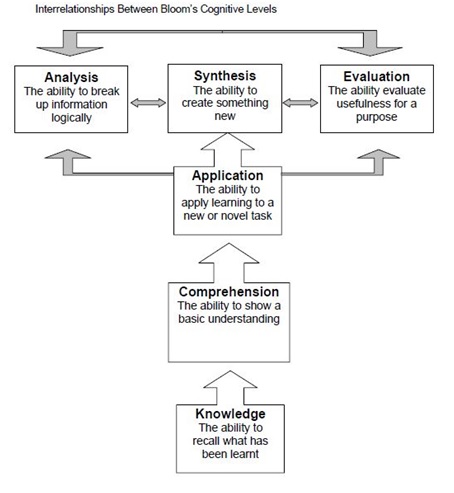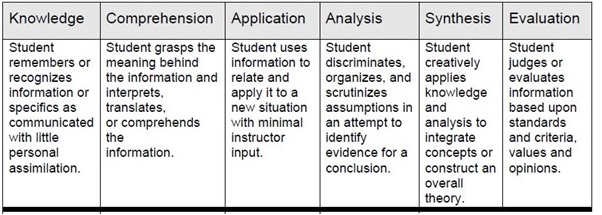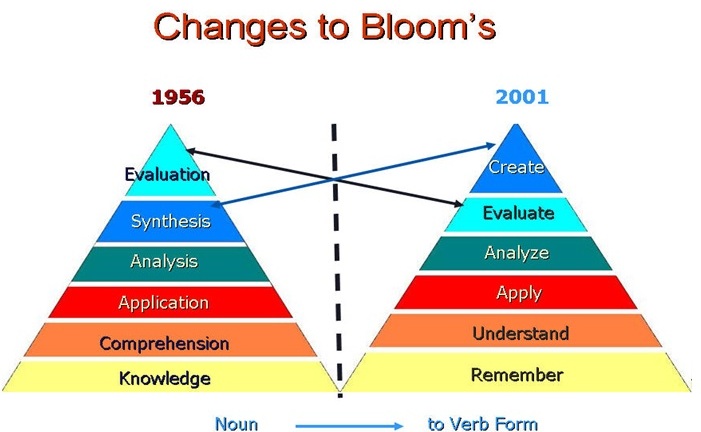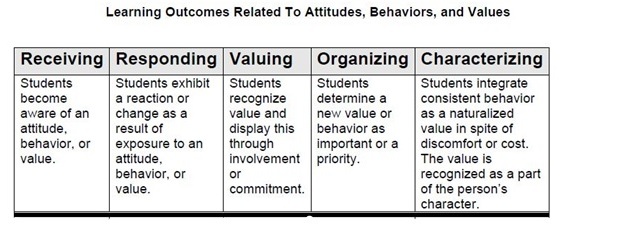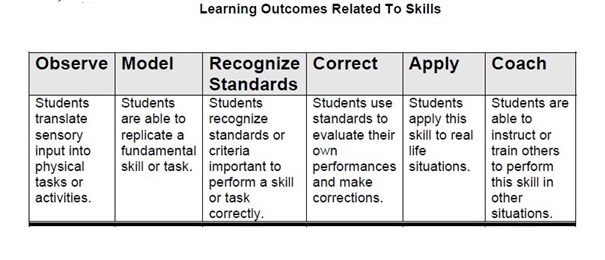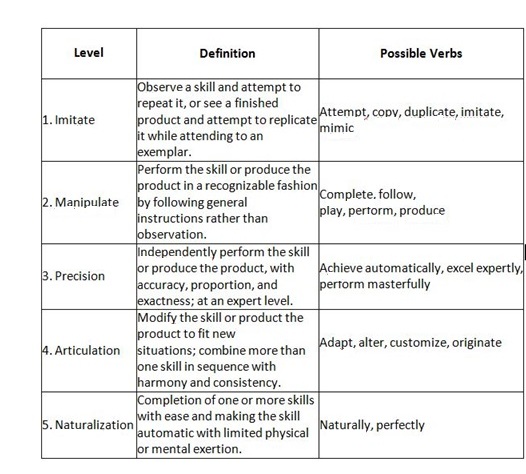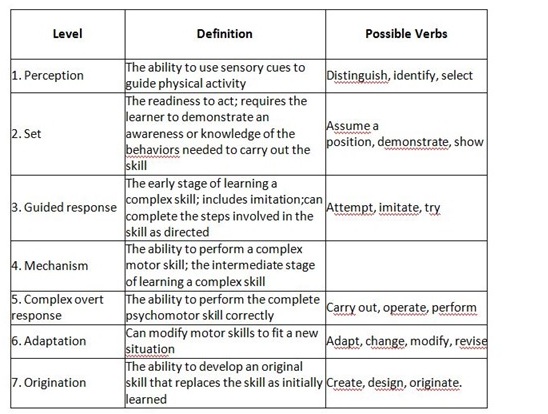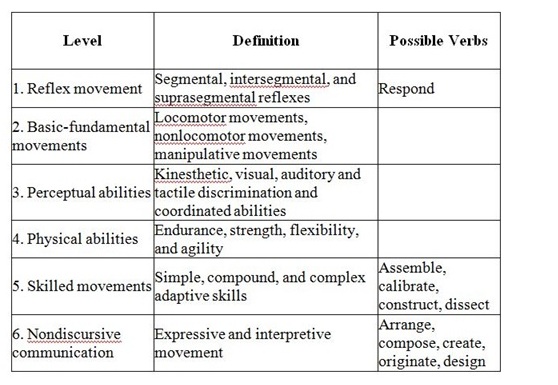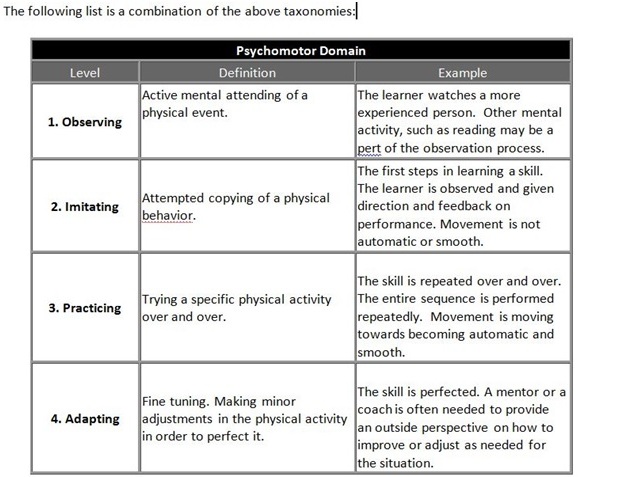Dr. V.K. Maheshwari, Former Principal
K.L.D.A.V (P.G) College, Roorkee, India
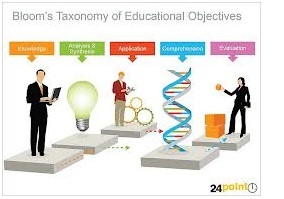
An objective is an goal or end point of something towards which actions are directed. Objectives generally indicate the end points of a journey. They specify where you want to be or what you intend to achieve at the end of a process. An educational objective is that achievement which a specific educational instruction is expected to make or accomplish. It is the outcome of any educational instruction. It is the purpose for which any particular educational undertaking is carried out.
Various Level of Educational objectives
Educational objectives can be specified at various levels. These levels include the national level, the institutional level and the instructional level..
At the National Level
At this level of educational objectives, we have merely policy statements of what education should achieve for the nation. They are in broad outlines reflecting national interests, values, aspirations and goals. It can be in the form of the National Policy on Education.
At the Institutional level
This is the intermediate objectives level. The aims are logically derived and related to both the ones at the national level and the one’s at the instructional levels. They are narrowed to achieve local needs like the kinds of certificate to be awarded by the institutions. These institutional objectives are usually specified by an act or edict of the house of assembly if it is a state government institution, otherwise by an act of the national Parliament.
At the Instructional Level
Since the schools are institutions consciously created to ensure desirable changes in human behaviour towards the ultimate realization of the national goals, they have to make conscious efforts to ensure the attainment of the goals. This can be done through a systematic translation of these objectives, and then to instructional objectives. Here, educational objectives are stated in the form in which they are to operate in the classroom. They are therefore referred to as instructional objectives.. They are specifically based on the intended learning outcomes. These objectives state what teaching is expected to achieve, what the learner is expected to learn from the instruction, how the learner is expected to behave after being subjected to the instruction and what he has to do in order to demonstrate that he has learnt what is expected from the instruction. These instructional objectives are therefore stated in behavioural terms with the use of action verbs to specify the desirable behaviour which the learner will exhibit in order to show that he has learnt
Importance of Instructional Objectives.
The instructional objectives are very important component of teaching system, as they provide the necessary feedback for the adjustments of curriculum, teaching method and teaching aids. They also show how appropriate the curriculum of the institution is. These instructional objectives can be used as a feedback on how much the institutional objectives have been achieved and how appropriate these objectives are.
The objectives start from broad goals at the national level to the instructional level. In the same way when evaluating these objectives, we use the instructional level objectives. From this, evaluation goes to the institutional to the national levels. In other words, the feedback got from the assessment of the instructional objectives is translated into finding and how much the national educational objectives have been achieved in respect to the particular type of institution, and their appropriateness.
At the instructional level, they may lead to the adjustment of teaching methods or provision of instructional materials. From the small things, activities, tests, examinations, projects, assignments, exercises, quizzes, home works etc done in the classroom setting, can be used to evaluate, in a general process, the national policy at the national level.
Apart from the feedback instructional objectives are also important because the teacher’s plans of what to teach and how to teach it is based on the objectives specified to be achieved. The evaluation of pupils’ learning outcome will make him know whether the objectives are being achieved or not. It means that the instructional objectives give meaning and direction to the educational process.
BLOOM’S TAXONOMY OF EDUCATIONAL OBJECTIVES
Bloom’s Taxonomy, (in full: ‘Bloom’s Taxonomy of Learning Domains’, or strictly speaking: Bloom’s ‘Taxonomy Of Educational Objectives’) was initially (the first part) published in 1956 under the leadership of American academic and educational expert Dr Benjamin S Bloom. Taxonomy means ‘a set of classification principles’, or ‘structure’, and Domain simply means ‘category’. ‘Bloom’s Taxonomy’ was originally created in and for an academic context, (the development commencing in 1948), when Benjamin Bloom chaired a committee of educational psychologists, based in American education, whose aim was to develop a system of categories of learning behaviour to assist in the design and assessment of educational learning. Bloom’s Taxonomy has since been expanded over many years by Bloom and other contributors (notably Anderson and Krathwhol as recently as 2001, whose theories extend Bloom’s work to far more complex levels and which are more relevant to the field of academic education).
Bloom’ Benjamin’s has put forward a taxonomy of educational objectives, which provides a practical framework within which educational objectives could be organized and measured. In this taxonomy Bloom divided educational objectives into three domains. These are;
Cognitive domain,
Affective domain and
Psychomotor domain.
Cognitive domain (intellectual capability, ie., knowledge, or ’think’)
The cognitive domain involves those objectives that deal with the development of intellectual abilities and skills. These have to do with the mental abilities of the brain.
The domain is categorized into six hierarchical levels , comprehension, application, analysis, synthesis and evaluation. These levels are of hierarchical and increasing operational difficulties that achievement of a higher level of skill assumes the achievement of the previous levels. This implies that a higher level of skill could be achieved only if a certain amount of ability called for by the previous level has been achieved.
Learning outcome in Cognative Domain
KNOWLEDGE (or Memory)LEVEL
Knowledge or memory is the first, the lowest and the foundation for the development of higher order cognitive skills. It involves the recognition or recall of previous learned information. For measurement purposes, memory or knowledge involves bringing to mind the appropriate material. This cognitive level emphasizes the psychological process of remembering. Knowledge is remembering or retrieving previously learned material.
Action verbs which can serve as appropriate. Examples of verbs that relate to this function are:
| know identify relate list |
define recall memorize repeat |
record name recognize acquire
|
These verbs can be used to formulate instructional objectives. Using these action verbs, specify some objectives in related subject area.
Knowledge can also be classified into the following:-
i. Knowledge of specifics (taxonomy, facts, definitions etc)
ii. Knowledge of ways and means of dealing with specifics (rules)
iii. Knowledge of conventions (styles, symbols practices, allegories)
iv. Knowledge of Trends and sequences (order or sequence)
v. Knowledge of classification and categories (classes, sets, divisions)
vi. Knowledge of criteria (established facts and criteria)
vii. Knowledge of Techniques and procedures or Methodology.
viii. Knowledge of universals and abstractions.
ix. Knowledge of principles and generalizations (laws, formulas)
x Knowledge of theories and structures (models, philosophies)
Questions inherent in Knowledge
What is …? How is …? Where is …? When did _______ happen? How did ______ happen? How would you explain …? Why did …? How would you describe …? When did …? Can you recall …? How would you show …? Can you select …? Who were the main …? Can you list three …? Which one …? Who was …?
COMPREHENSION or UNDERSTANDING LEVEL
Comprehension is the ability to grasp or construct meaning from material. Comprehension is all about internalization of knowledge. It involvers making memory out of what is stored in the brain file. It is on this basis that what is stored inthe brain can be understood and translated, interpreted or extrapolated. It is only when you have known something that you can understand it.
Action verbs which can serve as appropriate. Examples of verbs that relate to this function are:
| restate locate report recognize explain express |
identify discuss describe review infer conclude |
illustrate interpret draw represent differentiate
|
Comprehension level is made up of the following:
i. Translation: which involves the ability to understand literal messages across communication forms, changing what is known from one form of communication to another e.g. from words to numbers, graphs, maps, charts, cartoons, pictures, formulas, symbols, models, equations etc.
ii. Interpretation: which goes beyond mere literal translation to identification of inter-relationships among parts and components of communication and interpreting and relating these to the main components e.g. to interpret a chart or graph etc.
iii. Extrapolation: which involves the ability to draw implications and ability to identify and continue a trend, isolate or detect consequences, suggest possible meaning and estimate possible effect.
Questions inherent in Comprehension Level -
| How would you classify the type of …? How would you compare …? contrast …? Will you state or interpret in your own words …? How would you rephrase the meaning …? What facts or ideas show …? What is the main idea of …? Which statements support …? Can you explain what is happening . . . what is meant . . .? What can you say about …? Which is the best answer …? How would you summarize …? |
APPLICATION LEVEL
As per the hierarchic nature of the instructional objectives it is not possible to understand unless it is known.. It also means that one cannot apply what he/she do not understand. The use of abstractions in a concrete situation is called application. These abstractions can be in the form of general ideas, rules, or procedures or generalized methods, technical terms, principles, ideas and theories which must be remembered, understood and applied. Understanding before correct application is an essentiality.
In application the learner uses what he knows to solve a new problem, or in a new situation. Application involves the ability to the learner to grasp exactly what the problem is all about and what generalization or principles are relevant, useful, or pertinent for its solution. Application is the ability to use learned material, or to implement material in new and concrete situations.
Action verbs which can serve as appropriate. Examples of verbs that relate to this function are:
| apply relate develop translate use operate |
organize employ restructure interpret demonstrate illustrate
|
practice calculate show exhibit dramatize |
it involves the principles of transfer of learning.
Questions inherent in Application Level
How would you use …? What examples can you find to …? How would you solve _______ using what you have learned …? How would you organize _______ to show …? How would you show your understanding of …? What approach would you use to …? How would you apply what you learned to develop …? What other way would you plan to …? What would result if …? Can you make use of the facts to …? What elements would you choose to change …? What facts would you select to show …? What questions would you ask in an interview with …?
ANALYSIS LEVEL
Analysis is the breaking down of communication into its constituent parts or elements in order to establish the relationship or make the relations between ideas expressed to be clear or explicit. Analysis The ability to break down or distinguish the parts of material into its components so that its organizational structure may be better understood.
Action verbs which can serve as appropriate.. Examples of verbs that relate to this function are:
| analyze compare probe inquire examine contrast categorize |
differentiate contrast investigate detect survey classify deduce |
experiment scrutinize discover inspect dissect discriminate separate
|
The components here include:
i. Analysis of Elements: which is concerned with the ability to identify the underlying elements such as assumptions, hypothesis, conclusions, views, values, arguments, statements etc and to determine the nature and functions of such elements?
ii. Analysis of Relationship: which involves trying to determine how the elements identified are related to each other? For instance, how does the evidence relate to the conclusion?
iii. Analysis of Organizational principles: which involves determining the principles or system of organization which holds the different elements and parts together? It involves finding the pattern, the structure, systematic arrangements, point of view, etc.
Questions inherent in Analysis Level
What are the parts or features of _______? How is _______ related to _______? Why do you think______? What is the theme …? What motive is there …? Can you list the parts …? What inference can you make …? What conclusions can you draw …? How would you classify …? How would you categorize …? Can you identify the difference parts …? What evidence can you find …? What is the relationship between …? Can you make a distinction between …? What is the function of …? What ideas justify …?
SYNTHESIS LEVEL
Contrary to analysis which involves breaking down of materials, communication, object etc, in synthesis building up or putting together elements is processed. In other words, synthesis is concerned with the ability to put parts of knowledge together to form a new knowledge. Parts, pieces and components in order to form a unique whole or to constitute a new form, plan, pattern or structure. It involves categorizing of items, composing of poems, and songs, writing etc. it involves divergent thinking. It calls for imaginative, original and creative thinking. It calls for creative answers to problems and for the development of questioning mind, spirit of inquiry or inquisitive mind. It requires fluency of novel ideas and flexible mind. Synthesis is the ability to put parts together to form a coherent or unique new whole.
Action verbs which can serve as appropriate. Examples of verbs that relate to this function are:
| compose produce design assemble create prepare predict modify tell |
plan invent formulate collect set up generalize document combine relate |
propose develop arrange construct organize originate derive write propose |
Synthesis can be sub divided into:
(a) Production of unique communication: which is concerned with the ability to put together in a unique organizational form a piece of written or oral communication to convey a novel idea, feeling or experience to others?
(b) Production of a plan or proposed set of operations: this is concerned with the ability to develop a plan or to propose procedures for solving problem or dealing with others.
(c) Derivation of a set of Abstract Relation: this is based on the result of the analysis of an experimental data, observation or other specific. It is the ability to form concepts generalizations, deduce propositions, predictions or relationship based on classification of experiences or observations.
Questions inherent in Synthesis Level
What changes would you make to solve …? How would you improve …? What would happen if …? Can you elaborate on the reason …? Can you propose an alternative …? Can you invent …? How would you adapt ________ to create a different …? How could you change (modify) the plot (plan) …? What could be done to minimize (maximize) …? What way would you design …? What could be combined to improve (change) …? Suppose you could _______ what would you do …? How would you test …? Can you formulate a theory for …? Can you predict the outcome if …? How would you estimate the results for …? What facts can you compile …? Can you construct a model that would change …? Can you think of an original way for the …?
EVALUATION LEVEL
It is the top most level in the hierarchy. In education, evaluation as a cognitive objective involves the learners’ ability to organize his thought and knowledge to reach a logical and rational decision which is defendable. It involves making a quantitative or qualitative judgment about a piece of communication, a procedure, a method, a proposal, a plan etc. Based on certain internal or external criteria alternatives abound, choice depends on the result of judgment which we make consciously or unconsciously based on values we held. Evaluation is the most complex of human cognitive behaviour. It embodies elements of the other five categories. (knowledge, comprehension, application, analysis and synthesis). Evaluation is the ability to judge, check, and even critique the value of material for a given purpose.
Action verbs which can serve as appropriate. Examples of verbs that relate to this function are:
| judge assess compare evaluate conclude measure deduce |
argue decide choose rate select estimate |
validate consider appraise value criticize infer |
Evaluation can be subdivided into
(a) judgment in terms of internal criteria and
(b) judgment in terms of external criteria.
Questions inherent in Evaluation Level
Do you agree with the actions …? with the outcomes …? What is your opinion of …? How would you prove …? disprove …? Can you assess the value or importance of …? Would it be better if …? Why did they (the character) choose …? What would you recommend …? How would you rate the …? What would you cite to defend the actions …? How would you evaluate …? How could you determine …? What choice would you have made …? What would you select …? How would you prioritize …? What judgment would you make about …? Based on what you know, how would you explain …? What information would you use to support the view …? How would you justify …? What data was used to make the conclusion …? Why was it better that …? How would you prioritize the facts …? How would you compare the ideas …? people …?
REVISED B.S.BLLOM TAXONOMY OF INSTUCTIONAL OBJECTIVES
Anderson and Krathwohl in the year 1995-2000 revised the taxonomy of instructional objectives previously propounded by Bloom.
In the following table are the two primary existing taxonomies of cognition. The one on the left, entitled Bloom’s, is based on the original work of Benjamin Bloom and others as they attempted in 1956 to define the functions of thought, coming to know, or cognition. This taxonomy is over 50 years old.
Table – Bloom vs. Anderson/Krathwohl
Visual comparison of the two taxonomies
One of the things that clearly differentiates the new model from that of the 1956 original is that it lays out components nicely so they can be considered and used, and so cognitive processes as related to chosen instructional tasks can be easily documented and tracked. This feature has the potential to make teacher assessment, teacher self-assessment, and student assessment easier or clearer as usage patterns emerge.
The primary differences are not just in the listings or rewordings from nouns to verbs, or in the renaming of some of the components, or even in the repositioning of the last two categories. The major differences in the updated version is in the more useful and comprehensive additions of how the taxonomy intersects and acts upon different types and levels of knowledge — factual, conceptual, procedural and meta-cognitive.
AFFECTIVE DOMAIN (feelings, emotions and behaviour, ie., attitude, or ’feel’)
Previously the educationists never encourage emotionalism in education. They believe that intellectualism had nothing to do with the learner’s interests, emotions or impulses. Today, they have acknowledge that the learner’s feelings and emotions are equally important in education. In the year 1975 Tanner and Tanner insist that the primary goals of learning are affective. They are of the opinion that learners should not learn what is selected for them by others. This is because it amounts to imposition on the learners of other peoples values and purposes. This of course defys learners’ own feelings and emotions..
Krathwohl’s affective domain taxonomy is perhaps the best known of any of the affective taxonomies. “The taxonomy is ordered according to the principle of internalization. Internalization refers to the process whereby a person’s affect toward an object passes from a general awareness level to a point where the affect is ‘internalized’ and consistently guides or controls the person’s behavior .
Previously our school systems was the discipline-centred . Although the primary goal of a good teacher is to help students learn, not to make them feel good yet it is an important role of a good teacher to make students feel good about their efforts to learn and their success in learning. This will help to create a balance and interdependence between the cognitive and the affective processes of learningThe affective domain has to do with feelings and emotions. These are the emphatic characteristic of this domain of acceptance or rejection. It isconcerned with interests, attitudes, appreciation, emotional biases and values.
The function of the affective domain in the instructional situation pertains to emotions, the passions, the dispositions, the moral and the aesthetic sensibilities, the capacity for feeling, concern, attachment or detachment, sympathy, empathy, and appreciation.
Affective domain is generally covert in behaviour. The educational objectives here vary from simple attention to complex and internally consistent qualities of character and conscience.
Affective domain has five hierarchical categories. You remember that the cognitive domain has six hierarchical levels. Specifically, the levels in affective domain fall into these levels:
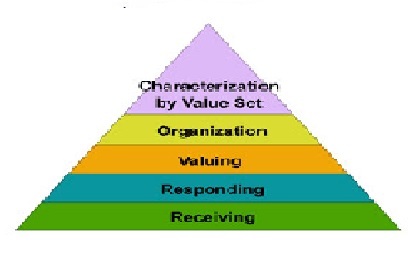
Receiving
This is the lowest level of the learning outcomes in the affective domain. It means attending. It is the learner’s willingness to attend to a particular stimulus or his being sensitive to the existence of a given problem, event, condition or situation. The learner is sensitized to the existence of certain phenomena; that is, that she/he be willing to receive or to attend to them.
Receiving has three sub-levels. These are:
i. Awareness: which involves the conscious recognition of the existence of some problems, conditions, situations, events, phenomena etc. take for instance as a teacher, you come into your class while the students are making noise. You will notice that the atmosphere will change. This is because the students have become aware of your presence. They are merely aware.
ii. Willingness: This is the next stage which involves the ability to acknowledge the object, event, problem instead of ignoring or avoiding it. The students in your class kept quite because they noticed and acknowledged your presence. If they had ignored your presence they would continue to make noise in the class.
iii. Controlled or selected attention: This involves the learner selecting or choosing to pay attention to the situation, problem, event or phenomenon. When you teach in the class, the learner is aware of your saying or the points you are making. In that case he will deliberately shut off messages or speeches or sounds as noises. Receiving in a classroom situation involves getting, holding and directing the attention of the learners to whatever the teacher has to say in the class.
Examples of Receiving
Listen to others with respect
Listen for and remember the name of newly introduced people.
Examples of verbs that relate to this function are
asks, chooses, describes, follows,
gives, holds, identifies, locates
, names, points to, selects, sits,
erects, replies, uses.
Responding
Here the learner responds to the event by participating. . Attends and reacts to a particular phenomenon. He does not only attend, he also reacts by doing something. Active participation on the part of the learners.
Learning outcomes may emphasize:
compliance in responding,
willingness to respond,
satisfaction in responding (motivation).
Responding has three sub-levels too. These are:
i. acquiescence in responding: which involves simple obedience orcompliance.
ii. Willingness to respond: This involves voluntary responses to a given situation.
iii. Satisfaction in response: if he is satisfied with the response he enjoys reacting to the type of situation.
Examples of Responding :
Participates in class discussions
Gives a presentation
Questions new ideals, concepts, models, etc. in order to fully understand them
.Know the safety rules and practices them.
Examples of verbs that relate to this function are
answers, assists, aids, complies,
conforms, discusses, greets, helps,
labels, performs, practices, presents,
reads, recites, reports, selects, tells, writes
Valuing
Valuing is related with the worth or value or benefit which a leaner attaches to a particular object, phenomenon ,behaviour or situation. This ranges from simple acceptance to the more complex state of commitment This ranges in degree from mere acceptance of value or a desire to improve group skills to a more complex level of commitment or an assumption of responsibility for the effective functioning of the group.. Valuing is based on the internalization of a set of specified values, while clues to these values are expressed in the learner’s overt behavior and are often identifiable.
There are three sub-levels of valuing:
i. Acceptance of a value: This is a situation where the learner believes tentatively in a proportion, doctrine, condition or situation.
ii. Preference for a value: In this case the learner believes in the desirability or necessity of the condition, doctrine, proposition etc. and ignores or rejects other alternatives and deliberately looks for other people views where the issues are controversial, so as to form his own opinion.
iii. Commitment to a value: In this stage the learner is convinced and fully committed to the doctrine, principle or cause. In consequence, the learner internalizes a set of specific values, which consistently manifest themselves in his event behaviour, attitudes and appreciation.
Examples of Valuing :
Demonstrates belief in the democratic process
. Is sensitive towards individual and cultural differences (value diversity).
Shows the ability to solve problems
. Proposes a plan to social improvement and follows through with commitment
. Informs management on matters that one feels strongly about.
Examples of verbs that relate to this function are
completes, demonstrates, differentiates, explains,
follows, forms, initiates, invites,
joins, justifies, proposes, reads,
reports, selects, shares, studies, works.
Organization
Here the learner starts to bring together different values as an organized system. He determines the interrelationships and establishes the order of priority by comparing, relating and synthesizing the values. He then builds a consistent value system by resolving any possible conflicts between them. He has to organize the values into a system in order to decide which value to emphasis .Organizes values into priorities by contrasting different values and, resolving conflicts between them, and creating an unique value system. The emphasis is on comparing, relating, and synthesizing values.
There are two sub-levels of organization . These are:
i. Conceptualization of a Value
This involves the understanding of the relationship of abstract elements of a value to these already held or to new values which are gaining acceptance. For example, the area of music where he/she may have to identify the characteristics of two types of music such as classical and hip up music, which he/she admire or enjoy in relation to the others such as jazz or highlife which you do not like.
ii. Organization of Value System?
This involves the development of a complex value system, which includes those values that cannot be compared for the purpose of making choices in order to promote public welfare, instead of the sheer aggrandizement of special personal interest. It is this level that leads individuals to develop vocational plan which can satisfy their needs for economic security and social welfare. It leads the individual to develop philosophy of life, which helps him to avoid dependence upon others, especially to avoid a situation where one becomes a public nuisance. Recognizes the need for balance between freedom and responsible behavior.
Examples of Organization:
Accepts responsibility for one’s behaviour
Explains the role of systematic planning in solving problems
Accepts professional ethical standards.
Creates a life plan in harmony with abilities, interests, and beliefs
Prioritizes time effectively to meet the needs of the organization, family, and self.
Examples of verbs that relate to this function are
: adheres, alters, arranges, combines,
compares, completes, defends, explains,
formulates, generalizes, identifies, integrates,
modifies, orders, organizes, prepares, relates, synthesizes.
Characterization by a Value or a Value Complex
Here the person acts consistently in accordance with such values, beliefs or ideals that comprise his total philosophy or view of life. A life-style which reflects these beliefs and philosophy are developed. The behaviour of such individuals or groups can be said to be controlled by the value system.Here it is possible to predict with accuracy how an individual would behave or respond. The behavior is pervasive, consistent, predictable, and most importantly, characteristic of the learner. Instructional objectives are concerned with the student’s general patterns of adjustment in personal, social, emotional domain.
There are two levels Value Complex of :
i. Generalized set: This involves a situation where the orientation of the individual enables him to reduce to order a complex environment and to act consistently and effectively in it. There may be room for the individual to revise his judgements and to change his behaviour as a result of available new and valid evidence.
ii. Characterization: In this case, the internalization of a value system is such that the individual is consistently acting in harmony with it. The value system regulates the individual’s personal and civil life according to a code of behaviour based on ethical principles.
Examples of Internalizing values
Shows self-reliance when working independently
. Cooperates in group activities (displays teamwork).
Uses an objective approach in problem solving.
Displays a professional commitment to ethical practice on a daily basis.
Revises judgments and changes behavior in light of new evidence
. Values people for what they are, not how they look.
Examples of verbs that relate to this function are
acts, discriminates, displays, influences,
listens, modifies, performs, practices
, proposes, qualifies, questions, revises,
serves, solves, verifies.
Psychomotor domain (manual and physical skills, ie., skills, or ’do’)
Psychomotor objectives are those specific to discreet physical functions, reflex actions and interpretive movements. Traditionally, these types of objectives are concerned with the physically encoding of information, with movement and/or with activities where the gross and fine muscles are used for expressing or interpreting information or concepts. This area also refers to natural, autonomic responses or reflexes.
It means that the instructional objectives make performance skills more prominent. The psychomotor domain has to do with muscular activities.
| The psychomotor domain includes physical and motor (or muscular) skills. Every act has a psychomotor component. In the learning situation there is again a progression from mere physical experience – seeing, touching, moving etc. – through the carrying out of complex skills under guidance, to the performance of skilled activities independently.
Psychomotor domain is sub divided into hierarchical levels. The six levels from simplest to most complex are: (i)Reflex movements (ii) Basic Fundamental movements (iii) Perceptual abilities (iv) Physical abilities (v) Skilled movements and (vi) Non-discursive communication |
Reflex Movements:
At the lowest level of the psychomotor domain is the reflex movements which every normal human being should be able to make.
Reflex movements are defined as involuntary motor responses to stimuli. They form the basis for all behaviour involving movement of any kind.
Objectives at this level include reflexes that involve one segmental or reflexes of the spine and movements that may involve more than one segmented portion of the spine as inter-segmental reflexes (e.g., involuntary muscle contraction). These movements are involuntary being either present at birth or emerging through maturation.
Basic Fundamental Movements:
Objectives in this area refer to skills or movements or behaviors related to walking, running, jumping, pushing, pulling and manipulating. They are often components for more complex actions.
Basic fundamental movements are defined as those inherent body movement patterns, which build upon the foundation laid by reflex movements. They usually occur during the first year of life, and unfold rather than are taught or consciously acquired. These movements involve movement patterns which change a child from a stationary to an ambulatory learner.
There are three sub-categories at this stage. These are:
i. Locomotor movement: which involves movements of the body from place to place such as crawling, walking, leaping, jumping etc.
ii. Non-locomotor movements: which involves body movements that do not involve moving from one place to another. These include muscular movements, wriggling of the trunk, head and any other part of the body. They also include turning, twisting etc of the body.
iii. Manipulative movements: which involves the use of the hands or limbs to move things to control things etc.
-Perceptual Abilities:
Objectives in this area should address skills related to kinesthetic (bodily movements), visual, auditory, tactile (touch), or coordination abilities as they are related to the ability of acquiring information from the environment and react.
Perceptual abilities are really inseparable from motor movements. They help learners to interpret stimuli so that they can adjust to their environment. Superior motor activities depend upon the development of perception. They involve kinaesthetic discrimination, visual discrimination, auditory discrimination and co-ordinated abilities of eye and hand, eye and foot.
Perceptual abilities are concerned with the ability of the individuals to perceive and distinguish things using the senses. Such individuals recognise and compare things by physically tasting, smelling, seeing, hearing and touching.
-Physical abilities:
Objectives in this area should be related to endurance, flexibility, agility, strength, reaction-response time or dexterity. Physical abilities are essential to efficient motor activity. They are concerned with the vigor of the person, and allow the individual to meet the demands placed upon him or her in and by the environment. These abilities fall in the area of health and physical education.
Skilled Movements:
Objectives in this area refer to skills and movements that must be learned for games, sports, dances, performances, or for the arts.
Skilled movements are defined as any efficiently performed complex movement. They require learning and should be based upon some adaptation of the inherent patterns of movement described in level number two above. This is a higher ability than the physical abilities.
There are three sub-levels of the skilled movements. These are:
Simple adaptive skills,
compound adaptive skills and
complex adaptive skills.
Non-Discursive Communication:
Objectives in this area refer to expressive movements through posture, gestures, facial expressions, and/or creative movements like those in mime or ballet. These movements refer to interpretative movements that communicate meaning without the aid of verbal commands or help. Non-discursive communication can be defined as comprising those behaviours which are involved in movement communication.
Every body that is normal can move his limbs and legs. But must have some level of training, practice and the ability to combine a variety of movements and some perceptive abilities in order to do diving, swimming, typing, driving, cycling etc.
There are two sub-levels of the non-discursive communication. They are:
expressive movement
and interpretive movement.
Primary taxonomies of the psychomotor domain:
Taxonomy developed by Dave
Dave (1970) developed this taxonomy of psychomotor domain:
- Imitation – Observing and copying someone else.
- Manipulation – Guided via instruction to perform a skill.
- Precision – Accuracy, proportion and exactness exist in the skill performance without the presence of the original source.
- Articulation – Two or more skills combined, sequenced, and performed consistently.
- Naturalization – Two or more skills combined, sequenced, and performed consistently and with ease. The performance is automatic with little physical or mental exertion.
Taxonomy developed by Simpson
Simpson (1972) built this taxonomy on the work of Bloom and others:
- Perception – Sensory cues guide motor activity.
- Set – Mental, physical, and emotional dispositions that make one respond in a certain way to a situation.
- Guided Response – First attempts at a physical skill. Trial and error coupled with practice lead to better performance.
- Mechanism – The intermediate stage in learning a physical skill. Responses are habitual with a medium level of assurance and proficiency.
- Complex Overt Response – Complex movements are possible with a minimum of wasted effort and a high level of assurance they will be successful.
- Adaptation – Movements can be modified for special situations.
- Origination – New movements can be created for special situations.
Taxonomy developed by Harrow
Harrow (1972) developed this taxonomy. It is organized according to the degree of coordination including involuntary responses and learned capabilities:
- Reflex movements – Automatic reactions.
- Basic fundamental movement – Simple movements that can build to more complex sets of movements.
- Perceptual – Environmental cues that allow one to adjust movements.
- Physical activities – Things requiring endurance, strength, vigor, and agility.
- Skilled movements – Activities where a level of efficiency is achieved.
- Non-discursive communication – Body language.
The taxonomy of educational objectives from the work of Professor B.S. Bloom and his colleagues has given us a sound base for the formulation of our objectives. A sound system of education should be able to produce graduates who have a wealth of knowledge and are able to comprehend much of it, and are also able to apply their knowledge and engage in those mental activities variously referred to as critical thinking, reflective thinking, divergent thinking, inductive-deductive processes, problem solving etc. these activities are concerned with the higher categories of the cognitive domain. These areas should form the bulk of the objectives because they are the ones from where we expect the highest educational dividends.

